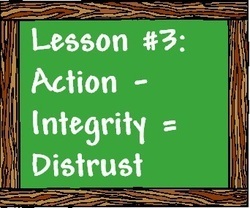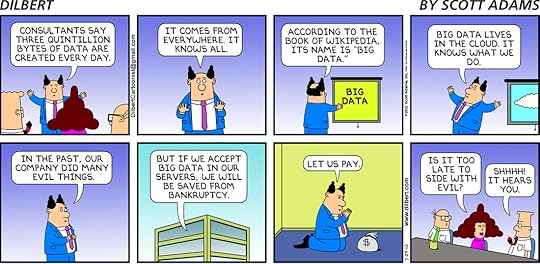Lonnie Pacelli's Blog, page 81
March 8, 2014
PM Slides from PM Connection
 I ran across this really nifty resource for project managers on . They've aggregated over 100 project management slide decks on PMP certification, Microsoft Project, Microsoft Project Server, Program Management, Portfolio Management, and other topics. Very cool resource! Amazon.com Widgets
I ran across this really nifty resource for project managers on . They've aggregated over 100 project management slide decks on PMP certification, Microsoft Project, Microsoft Project Server, Program Management, Portfolio Management, and other topics. Very cool resource! Amazon.com Widgets
Published on March 08, 2014 07:15
Work-Life Balance is False?
Bustle published a piece about a Senior Vice President at Coca Cola claiming that work-life balance is false and work-life integration is in. In today's world of hyper-connectedness it does become more and more difficult to separate work and non-work. At the same time, sometimes the answer to work simply has to be "NO". The best leaders I know put clear boundaries on things and empower key members of their staff to make decisions for them when they're out of pocket. In the article the exec talks about how she had to step away from putt-putt golf with her kids to do an email and that the kids should play the next couple of holes on their own. A parent can phrase things any way they want, but the kids know that they are being deprioritized during a time when they are expecting the parent's 100% attention.
As a leader, it is super important that you establish those boundaries, empower your team to act in your place when you're out of pocket, and make sure your family doesn't feel deprioritized when they're expecting your dedicated attention. My kids are now grown and I can look back on the amount and quality of time I spent with them growing up with absolutely no regret. When they're grown and gone you don't want to be wishing you spent more focused time with them. That bell has already been rung.
OK, end rant.
Amazon.com Widgets
As a leader, it is super important that you establish those boundaries, empower your team to act in your place when you're out of pocket, and make sure your family doesn't feel deprioritized when they're expecting your dedicated attention. My kids are now grown and I can look back on the amount and quality of time I spent with them growing up with absolutely no regret. When they're grown and gone you don't want to be wishing you spent more focused time with them. That bell has already been rung.
OK, end rant.
Amazon.com Widgets
Published on March 08, 2014 07:15
Big Data is for Everyone, Not Just Data Geeks
Silicon Angle published this article on Big Data. Does Big Data lead to George Orwell's Big Brother? You decide.
Published on March 08, 2014 07:13
Three Things Big Data Tells Us About How People Use the Bible
Big Data is enabling new and better ways for organizations to achieve their objectives by understanding their target market and helping consumers find what they need. A great example of this is from this Religion News Service article. Popular bible software YouVersion released its summary of its bible usage data from 2013. Through its own data mining capability, YouVersion is able to aggregate what people look for in scripture. Another super interesting use of Big Data.
Published on March 08, 2014 07:10
February 28, 2014
How an Autistic Child has Changed a Career….for the Better
 Typically, career choices are made based upon responsibilities, compensation, or prestige where a businessperson makes a change to get a higher salary, more responsibility, or greater prestige. What about the situation, though, where the driver behind a career choice isn’t any of these; where it’s the needs of a child that drive the change? My choice was precisely that.
Typically, career choices are made based upon responsibilities, compensation, or prestige where a businessperson makes a change to get a higher salary, more responsibility, or greater prestige. What about the situation, though, where the driver behind a career choice isn’t any of these; where it’s the needs of a child that drive the change? My choice was precisely that.Trevor was a happy, normal, active baby. He was able to laugh, coo, cry, and do all of the other normal things that his big sister, Briana did at that age. To my wife Patty and me, everything seemed to be just fine. At about age two, we noticed that Trevor was hardly saying any words and was very into his own world with puzzles, coloring, and videos.
Over the next couple of years, we took him to a speech therapist to help him with his language and also enrolled him in a special-needs preschool. During this time we noticed other peculiar characteristics for a toddler; a strong desire for structure (his preschool teachers called him “Mr. Rigid”), obsessive fixations on various topics, and no real desire to associate with other children. Yet Trevor was very easy in that he would keep himself occupied for hours on end playing by himself and acting out whatever imaginary things he could think of. It was very perplexing to us
Amazon.com Widgets When Trevor was five, we took him to specialists at the Autism Center at the University of Washington who conducted a series of tests to assess speech, cognitive understanding, and relational behaviors. At the end of the assessment, one of the specialists explained that Trevor had Pervasive Developmental Disorder – Not Otherwise Specified (PDD-NOS), a mild form of autism. This was odd to us because we had associated autism with more severe cases (think about Dustin Hoffman in “Rainman”) where speech was limited to non-existent at all and no real interaction between the child and others. Trevor was able to speak and interact but was about two years behind his peers developmentally. The specialist explained that, while Trevor had many characteristics of “normal” children, he saw the world as if peering through a rolled-up newspaper; he had a narrow focus on the world and was inattentive to things that didn’t interest him or how other people perceived him. To give you an example, think of Jack Nicholson in the movie “As Good as it Gets”. His character, Melvin Udall, was a bright, successful author who was obsessed with cleanliness, kept a very rigid schedule, did not walk on sidewalk cracks, and was generally unaware of how he came off to others. Though he wasn’t labeled as such, Melvin could have had PDD-NOS.
In some respects, knowing that Trevor had a milder form of autism was a relief in that he could learn to control his behaviors and be a high-functioning adult. In other respects, though, having a milder form of autism puts him in a sort of purgatory when it comes to other kids. He doesn’t fit in a traditional special-needs category yet he is clearly unique when compared to other children. Had Trevor grown up prior to the 90’s, his actions would have been viewed as a behavioral problem and he would have been labeled a difficult child. The truth is Trevor isn’t a behavioral problem; he’s just wired differently than normal children.
Trevor’s public elementary school was wonderful in working with him; he qualified for special services and was able to get one-on-one assistance with a special education teacher. While we’ve been very appreciative of the attention the public school system has afforded him through sixth grade, we grew concerned about his transition to middle school. Through a lot of discussion, we’ve decided the best thing for Trevor is to pull him out of mainstream school in seventh grade and take on a more customized home-school approach. In thinking through this, Patty and I decided that, for Trevor to have the best opportunity to succeed, we needed to share the teaching responsibilities. I had spent eleven years at Accenture and was in my ninth year at Microsoft and was very happy with my career. At the same time we also realized the importance of giving Trevor the best possible educational experience to secure his leading a normal adult life. We decided it best for me to leave my secure, full-time job at Microsoft to focus on a new career which gave us more flexibility to tend to Trevor. It was at this same time that I had written a book called The Project Management Advisor which was in process of being published. I had also just started a meals-delivered-to-your-door business called delBistro with a friend. The timing seemed perfect to take the plunge and leave Microsoft to build a new career as an author and entrepreneur around ensuring Trevor gets what he needs to secure a normal, happy adult life.
This past six months has been focused on me adjusting to my new career as author and entrepreneur and us beginning research on how we are going to approach home-schooling Trevor. Already I’ve seen great benefit in being more available to my family and in Trevor getting used to me being around more often. I’ve got tremendous peace with the career choices that I’ve made and see focusing on Trevor as being far more important than any promotions or accolades I could have received at Microsoft or some other traditional job. Our goal is to ensure that, by September, we are positioned to home-school Trevor and that my career activities don’t interfere with our home-schooling priorities. By the way, Trevor’s social-butterfly-sister has already made it very clear that home-schooling is not her cup of tea so she’ll stay in the public school system.
I realize that a choice like the one I’ve made when you have an autistic child may not always be feasible. We’ve been very blessed in having the financial means and opportunities to make this decision. What I can say, though, is this investment in Trevor’s future will yield a return that is far greater than any return I could be getting in a more traditional career and see this as the smartest career choice I’ve ever made.
Published on February 28, 2014 08:43
Stresspensation: Evaluating the Impact of Stress in Career Decision Making
 Brad was an incredibly bright young executive with a very promising future. Ever since graduating college, he seemed to take on increased responsibilities in his company like a duck to water. He married his college sweetheart, Nancy, right after graduation and has two small children. Brad's talent didn't go unnoticed in the industry, with several competitors approaching Brad about his willingness to join another firm. He steadfastly resisted, that is until the offer of all offers came his way.
Brad was an incredibly bright young executive with a very promising future. Ever since graduating college, he seemed to take on increased responsibilities in his company like a duck to water. He married his college sweetheart, Nancy, right after graduation and has two small children. Brad's talent didn't go unnoticed in the industry, with several competitors approaching Brad about his willingness to join another firm. He steadfastly resisted, that is until the offer of all offers came his way. Cantata Group, a larger and more prominent competitor to his current company, wined and dined Brad and ultimately offered him a VP position with a higher salary and better benefits. The offer was too good to pass up so Brad talked with Nancy about the job and they both became enamored with how this was going to advance Brad's career and what they would be able to do with the extra money. Brad joyfully accepted Cantata's offer, gave his current company two weeks' notice, and started in his new VP role.
Within a year of joining Cantata, he noticed some unexpected side effects of his new position. He was required to be in weekly global executive virtual meetings which could happen at any time of the day or night. He was routinely working 60+ hours a week, missing dinner with Nancy and the kids. He traveled at least once a week, many times to put out fires at clients. His eating habits were horrendous and he wasn't exercising due to his schedule. He began putting on weight. Nancy was frustrated with him not being around and his kids missed their daddy. The stress was unbearable and led to Brad one day grabbing his chest and collapsing during a customer meeting.
While the above story about Brad is fictional, each one of us knows of a Brad (or perhaps is Brad) who made a career choice without considering the effects of the extra stress. The American Institute of Stress (yes there is such an organization) has quantified the cost of stress to employers at $300 billion annually due to things such as absenteeism, accidents, turnover, diminished productivity, and medical costs. Add to that the personal costs of stress (i.e., poor health, weight gain/loss, sleep deprivation) and the relationship costs of stress (i.e., fractured relationships, friends or loved ones alienation, missed school plays), and you have a perfect storm of negative factors which make any kind of work-life balance virtually impossible to attain. In my 30 years of working with career professionals, stress typically takes a back seat to compensation and when considered, it is usually only a slice of the true stress level that the professional will endure. In the first ten years of my own career I saw stress as a given and gave it no consideration when evaluating career alternatives. This was a big mistake and a lesson I learned the hard way. Fortunately I learned it early in my career and was able to make some positive changes. However, some professionals never get it. To help the professional evaluate the impact of stress when deciding on a career change, I've defined a comparative increase/decrease method to evaluate the impact of stress, based on three stress types:
(a) Relationship Stress
(b) Work Stress
(c) Personal Stress
For each stress type, a qualitative degree of stress is defined as follows:
1 - Mimimal Stress
2 - Moderate Stress
3 - Significant Stress
In evaluating the impact of stress, each of the three stress types is assigned a value for the current and new job alternatives, then a comparative increase/decrease assessment is derived for each stress type. Let's put this to an example.
Lets say that a systems analyst (I'll call her Ann) is currently in a job paying $90,000/year and she's been offered a new position paying $100,000/year. On the surface, Ann likes the idea of a $10k raise and looks at the three stress types for each job, as follows:
Current Position
Relationship stress = 2 due to infrequent evening meetings only.
Personal stress = 1 due to ability to keep up with personal interests without sacrifice
Work stress = 2 due to some tight deadlines.
New Position
Relationship stress = 3 due to evening meetings and four international trips/year to work with offshore developers Personal stress = 2 due to having to alter exercise schedule, and having to drop book club Work stress = 3 due to mission critical deadlines and regular status updates to senior management.
When you look at the three stress types the following pops out about the new position:
 Ann is now faced with the following decision: Is the salary bump of $10k worth the incremental relationship, personal and work stress she'll endure? Depending on whatever other decision criteria Ann factors into her decision, the answer could be yes or no. Whether or not she takes the job is still her decision; what the process has done is forced her to consider the three stress types and derive data points in which she can use in her overall decision-making.
Ann is now faced with the following decision: Is the salary bump of $10k worth the incremental relationship, personal and work stress she'll endure? Depending on whatever other decision criteria Ann factors into her decision, the answer could be yes or no. Whether or not she takes the job is still her decision; what the process has done is forced her to consider the three stress types and derive data points in which she can use in her overall decision-making.There are a number of important considerations for you to digest in using this methodology. First, this is not an autonomic decision-making tool where the numeric answer is the sole job determinant. The impact of stress methodology is meant to bring relationship, personal, and work stress factors to the forefront of your decision making process. Second, you need to be realistic about stress levels. "Wishing down" a stress level doesn't make it go away; it just sets you up for a letdown (or worse) after you've made your decision. Third, you need to let your friends and loved ones come up with the relationship stress value and not assume a value for them. The real benefit in the methodology is the thought process and discussions you have along the way. Don't shortcut how your stress type values are determined or you'll miss out on some valuable nuggets. Fourth, the methodology applies to any type of career change which involves new or different responsibilities, including promotions. Most of us are wired to blindly accept promotions without regard for the additional stress which may accompany the promotion. Fifth, there will likely be stress in any job change; make sure you look at your steady-state stress level versus the "learning curve" stress level.
"Relationship, personal and work stress must be actively and realistically discussed and considered during the career choice decision making process."Amazon.com Widgets Your Go-Dos
When faced with your next career decision, follow these five steps to assess your impact of stress and help you decide on your career choice course of action:
Ask a lot of questions about the job and the degree of relationship, personal and work stress entailed in the job. Seek out others who may have done the job before or others who have some inside perspective. Look at the job responsibilities (both stated and those you derive through interviews) and determine how much stress each of the responsibilities will create for you. Decide on a 1-3 work stress value.
Write down the personal activities and goals you have (i.e. exercise 4x/week, sleep at least 7 hours a night) and determine how the career choice would impact each of the activities and goals. Decide on a 1-3 personal stress value.
Openly discuss with your friends and loved ones what the career choice would mean in terms of impact to relationship time (i.e. not being home for dinner, availability to help with homework) and ask them to decide on a 1-3 relationship stress value.
Derive the increase/decrease in stress for each of the three stress types.
Decide how you're going to factor the impact of stress into your overall decision.
Remember, the real benefit in utilizing the impact of stress methodology is in the discovery process you'll go through to understand relationship, personal, and work stress drivers for different career choices. Be real with yourself as to how a career choice will affect you and those you love.
Lonnie Pacelli has 30 years of experience helping leaders and project managers help themselves to be more effective. See more at LonniePacelli.com
Published on February 28, 2014 08:43
California Fights Drought with Big Data, Cloud Computing
 Computerworld published an interesting piece which talks about how the East Bay Municipal Utility District is using both Cloud Computing and Big Data to issue report cards on water usage to some of its customers. I really like the use of data to inform customers on their usage and appeal to their common sense to be more conscious of how much water they use. In the end the customer gets to choose what they do with the information. Nice application of both Big Data and Customer Computing. Amazon.com Widgets
Computerworld published an interesting piece which talks about how the East Bay Municipal Utility District is using both Cloud Computing and Big Data to issue report cards on water usage to some of its customers. I really like the use of data to inform customers on their usage and appeal to their common sense to be more conscious of how much water they use. In the end the customer gets to choose what they do with the information. Nice application of both Big Data and Customer Computing. Amazon.com Widgets
Published on February 28, 2014 08:43
The 9 Top Jobs for Work-Life Balance
 US News & World Report published their take on the 9 top jobs for work life balance. I agree with most of them, but #9 took me by surprise. What do you think?
US News & World Report published their take on the 9 top jobs for work life balance. I agree with most of them, but #9 took me by surprise. What do you think?
Published on February 28, 2014 08:43
Action - Integrity = Distrust
 Andrew was your prototypical type-A personality. He was a very hard driver who wasn’t afraid to take on hard tasks, work until midnight, and produce a finished product ahead of schedule. Andrew took great pride in his ability to deliver results and expected to be well-rewarded for his work.
Andrew was your prototypical type-A personality. He was a very hard driver who wasn’t afraid to take on hard tasks, work until midnight, and produce a finished product ahead of schedule. Andrew took great pride in his ability to deliver results and expected to be well-rewarded for his work. The team leader in Andrew’s organization was transferred to another organization and Barb, the organization’s director, took on the task to find a new team leader. Andrew was very excited to interview for the position and felt that with his history of delivering results he was a shoo-in for the job. Andrew went through the interview process along with two other candidates. After the interviews were complete, Barb announced Alice, one of Andrew’s peers, as the new team leader. Andrew’s heart sank at the news and he couldn’t believe that Alice was chosen over him given his track record.
After a few days passed, Andrew asked Barb if they could grab a cup of coffee and talk about Barb’s decision to hire Alice over Andrew. Barb agreed and the two went out for coffee. “Barb, I just don’t understand why I wasn’t chosen for the position,” Andrew said. “I deliver better than anyone on the team and am your top performer; why didn’t I get the job?” “I’m glad you asked, Andrew,” Barb started. “You work incredibly hard and make a tremendous effort, but I’m not comfortable that you can lead a team effectively yet. You appear to take a ‘What’s best for Andrew’ approach to your work and I don’t feel comfortable that you will consistently lead with the interests of the organization in mind. The motivations under which you operate cause other team members to question your integrity, which is a fundamental requirement for any leader, regardless of how action-oriented he or she is. You need to work on this issue before you’re entrusted with a team, Andrew; I hope you’re able to address this and become a strong leader in the future.” Andrew couldn’t help but do some serious introspection on his motives and made a commitment to address any question about his integrity.
How should Andrew have handled things differently? See how in Why Don't They Follow Me?
Published on February 28, 2014 08:43
February 27, 2014
Dilbert on Big Data
Published on February 27, 2014 21:47




